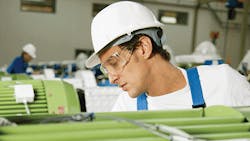Integrated PPE: Thinking about Eye Protection as Part of a PPE System
When thinking about personal protective equipment, we should view "the head" as the total head – including brain, eyes, ears, mouth, etc. – and focus exclusively and relentlessly on safeguarding it. Work injuries that occur above-the-neck are, after all, the most likely to result in death or permanent disability. We believe that by protecting the head, the creativity and judgement that shape our world is safeguarded.
We recently conducted research to gain insights from more than 250 safety professionals, purchasing officers and end users that focused on the key aspects of selecting, purchasing, testing and ultimately wearing above-the-neck personal protective equipment (PPE) solutions.
When asked to rank from 1 to 10, the key factors when selecting PPE, specifiers, purchasers and wearers continue to place considerable importance on:
- Comfort for the wearer (55 percent gave this a 9 or 10 in importance).
- Compatibility of the product with other equipment (45 percent gave this a 9 or 10 in importance).
- Style and how it contributes to the company and wearer's image (19 percent rated this as a 7-to-10 in importance).
The research uncovered an increasing concern and need for hassle-free selection and compatibility. Both specifiers and the end users want to feel more confident that their PPE (i.e. hardhats, eyewear, face protection and hearing protection) is compatible.
Checking products for compatibility, various risks and the necessary regulations is daunting, especially above the neck, where stakes are at their highest. One of the clearest solutions to this problem is to embrace head protection more as a system and intuitively integrate key elements.
Compatibility
The frustrations around compatibility reveal that still more can be done to drive awareness for such solutions. There are several benefits when considering integrated eyewear in a head protection system.
Increased impact protection: Within EN 166, there are different grades of impact strength given to eyewear and face protection. Stand-alone safety glasses conform to grade F (low-energy impact), which equates to withstanding an impact from an object traveling up to 45 meters per second (145 feet per second). Integrated eyewear systems often can provide a higher level of impact protection.
Eye protection requirements under ANSI in the United States are divided between basic Z87 approval and the more stringent High Impact Z87+ standard. For approval to Z87+, safety glasses must pass a high mass test of dropping a 500-gram, pointed weight from a height of 5 feet onto the lens. Safety glasses also must withstand a test where a ¼-inch steel ball is shot at the lens at 102 MPH from a distance of 150 feet to meet the Z87+ approval.
Accommodating prescription eyewear: The use of prescription glasses in the general population is increasing globally. In East Asia, for example, 80-90 percent of urban dwellers who are age 18 or older suffer from near-sightedness. In the UK, the rate of people wearing prescription glasses has increased 8 percent over the last 5 years, from 61 percent in 2011 to 69 percent in 2016.
For the UK, this poses a health and safety challenge; of the 17.4 million employees in non-office jobs, 12 million will be wearing prescription glasses while performing their day-to-day work tasks.
A key advantage of integrated eyewear within the head protection system is that a significant proportion of solutions available are designed to allow prescription glasses to be worn underneath the integrated safety eyewear. One of the alternative safety eyewear solutions is to provide workers with prescription safety eyewear. Another option is to wear special safety eyewear over prescription glasses, which can be uncomfortable and therefore reduce likelihood of usage.
Reduced costs: Health and safety professionals and facilities managers continue to cite frequent loss or damage of the safety eyewear issued to workers as a problem. This issue not only has a financial implication (for replacements), but also raises the question of inappropriate eyewear being worn for certain tasks, putting workers at risk of injury.
It is all too easy for safety eyewear to become damaged or scratched once removed. Workers often place them on tables or benches among tools, or put them in pockets where the lenses can be scratched by keys and other objects. Workers also run the risk of dropping them or dropping tools or other heavy objects on their safety glasses, which can break both lens and frames.
An integrated system puts the safety eyewear out of harm's way (within the hard hat), ensuring it stays damage-free and eliminating the likelihood of the eyewear being removed and misplaced.
Over a prolonged period, through the reduction of loss and damage to eyewear, a head protection system can save significant cost. According to our 2015 extensive market study, companies can save up to 29 percent (versus premium head protection and standalone safety glasses) annually per worker.
Comfort and compliance: PPE compliance can be simplified by the introduction of comfortable equipment. Conversely, even the most protective safety glasses offer no protection at all when the user keeps them on top of their head, or avoids wearing them altogether due to discomfort. Issues introduced by too much pressure on the temples or bridge of the nose and poor fit leading to slippage and ineffective coverage are eliminated with the use of eye protection integrated into the hard hat.
With so many benefits to the specifier and end user, it comes as no surprise that hard hats with integrated eyewear is a growing trend. When the systems are designed to overcome compatibility concerns – and with comfort top of mind – employees are more likely to wear their PPE and avoid eye and head injuries.
Andrew Gordon is marketing director, Centurion Safety Products Ltd. Lee Ptasnik is president, Mine & Process Service Inc.
